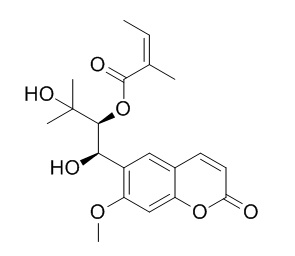Angelol A
Angelol A and angelol B are passive diffusion as the dominating process in Caco-2 cell monolayer model.
Inquire / Order:
manager@chemfaces.com
Technical Inquiries:
service@chemfaces.com
Tel:
+86-27-84237783
Fax:
+86-27-84254680
Address:
1 Building, No. 83, CheCheng Rd., Wuhan Economic and Technological Development Zone, Wuhan, Hubei 430056, PRC
Providing storage is as stated on the product vial and the vial is kept tightly sealed, the product can be stored for up to
24 months(2-8C).
Wherever possible, you should prepare and use solutions on the same day. However, if you need to make up stock solutions in advance, we recommend that you store the solution as aliquots in tightly sealed vials at -20C. Generally, these will be useable for up to two weeks. Before use, and prior to opening the vial we recommend that you allow your product to equilibrate to room temperature for at least 1 hour.
Need more advice on solubility, usage and handling? Please email to: service@chemfaces.com
The packaging of the product may have turned upside down during transportation, resulting in the natural compounds adhering to the neck or cap of the vial. take the vial out of its packaging and gently shake to let the compounds fall to the bottom of the vial. for liquid products, centrifuge at 200-500 RPM to gather the liquid at the bottom of the vial. try to avoid loss or contamination during handling.
Pharmacia2022, 69(3): 883-890.
Evid Based Complement Alternat Med.2018, 2018:8565132
Fitoterapia.2024, 175:105955.
Antioxidants (Basel).2021, 10(9):1435.
Plant Methods.2017, 13:108
J Nat Prod.2018, 81(4):966-975
Revista Brasileira de Farmacognosia2024, 34:1156-1165.
J of the Korean Society of Food Science and Nutrition2016, 45(7):1017-1025
Rev. Chim.2020, 71(3),558-564
Current Traditional Medicine, 2021, 7:326-335(10).
Related and Featured Products
Zhong Xi Yi Jie He Xue Bao. 2008 Apr;6(4):392-8.
Absorption and transport of 6 coumarins isolated from the roots of Angelica pubescens f. biserrata in human Caco-2 cell monolayer model.[Pubmed:
18405608]
To study the absorption and transepithelial transport of six coumarins (umbelliferone, osthole, columbianadin, columbianetin acetate, Angelol A and angelol B, isolated from the roots of Angelica pubescens f. biserrata) in the human Caco-2 cell monolayer model.
METHODS AND RESULTS:
The in vitro cultured human colon carcinoma cell line, Caco-2 cell monolayer model, was applied to study the absorption and transport of the six coumarins from apical (AP) to basolateral (BL) side and from BL to AP side. The six coumarins were measured by reversed-phase high-performance liquid chromatography (HPLC) coupled with ultraviolet absorption detector. Transport parameters and apparent permeability coefficients (P(app)) were calculated and compared with those of propranolol as a control substance of high permeability and atenolol as a control substance of poor permeability. The transport mechanism of angelol B was assayed by using iodoacetamide as a reference standard to inhibit ATP-dependent transport and MK571 as a well-known inhibitor of MRP2.
The absorption and transport of six coumarins were passive diffusion as the dominating process. The P(app) values of umbelliferone, osthole, columbianadin, columbianetin acetate, Angelol A and angelol B from AP to BL side were (2.679+/-0.263) x 10(-5), (1.306+/-0.324) x 10(-5), (0.595+/-0.086) x 10(-6), (2.930+/-0.410) x 10(-6), (1.532+/-0.444) x 10(-5) and (1.413+/-0.243) x 10(-5) cm/s, and from BL to AP side were (3.381+/-0.410) x 10(-5), (0.898+/-0.134) x 10(-5), (0.510+/-0.183) x 10(-6), (0.222+/-0.025) x 10(-6), (1.203+/-0.280) x 10(-5) and (0.754+/-0.092) x 10(-5) cm/s, respectively. In this assay, the P(app) value of propranolol was 2.18 x 10(-5) cm/s and the P(app) value of atenolol was 2.77 x 10(-7) cm/s. Among the 6 coumarins, the P(app) values of umbelliferone, osthole, Angelol A and angelol B from AP to BL side were identical with that of propranolol, and columbianadin and columbianetin acetate lied between propranolol and atenolol. When replaced the HBSS with EBSS, and iodoacetamide or MK-591 were used in the experiment, the P(app) of angelol-B had no statistical difference as compared with the control group. In the mean total recoveries, umbelliferone was (83.31+/-3.52)%, Angelol A was (77.39+/-7.38)%, osthole, columbianadin and angelol B were between 50% to 65%, and columbianetin acetate was lower than 10%. The accumulation rates of osthole and columbianadin in the Caco-2 cells were (36.15+/-5.87)% and (53.90+/-4.39)%, respectively.
CONCLUSIONS:
The absorption and transport of umbelliferone, osthole, columbianadin, columbianetin acetate, Angelol A and angelol B are passive diffusion as the dominating process in Caco-2 cell monolayer model. Umbelliferone, osthole, Angelol A and angelol B are estimated to be highly absorbed compounds, and columbianadin and columbianetin acetate are estimated to be moderately absorbed compounds. In the Caco-2 cells, osthol and columbianadin appear to accumulate, and columbianetin acetate may be metabolized. The absorption and transport of angelol B are not influenced by the change of pH and the presence of iodoacetamide or MK571.
Chinese Traditional & Herbal Drugs, 2014, 45(13):1820-1828.
New natural product from lipophilic parts in roots of Angelica dahurica.[Reference:
WebLink]
To study the chemical constituents of lipophilic parts from the roots of Angelica dahurica.
METHODS AND RESULTS:
The compounds were separated and purified by repeated column chromatography on silica gel and HPLC, as well as the chemical structures of isolated compounds were determined by spectral data analyses. Forty compounds were obtained and identified as isoimperatorin (1), psoralen (2), bergapten (3), β-sitosterol (4), imperatorin (5), phellopterin (6), xanthotoxin (7), isopimpinellin (8), dehydrogeijerin (9), isooxypeucedanin (10), oxypeucedanin (11), dibutylphthalate (12), umbelliferone (13), xanthotoxol (14), 5-hydroxy-8-methoxypsoralen (15), p-hydroxyphenethyl-trans-ferulate (16), pabularinone (17), isobyakangelicol (18), heraclenin (19), columbianetin (20), isogosferol (21), pabulenol (22), byakangelicin ethoxide (23), neobyakangelicol (24), oxypeucedanin methanolate (25), isoscopletin (26), 1′, 2′-dehydromarmesin (27), Angelol A (28), angelol E (29), tert-O-methylheraclenol (30), (-)-marmesin (31), dahurianol {8-[(2′R)-2′, 3′-dihydroxy-3′-methylbutoxy] bergaptol; 32}, oxypeucedanin hydrate (33), heraclenol (34), byakangelicin (35), angelol L (36), angelol G (37), trans-coniferylaldehyde (38), vanillic acid (39), and trans-ferulic acid (40), respectively.
CONCLUSIONS:
Compound 32 is a new natural product named dahurianol.



